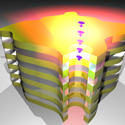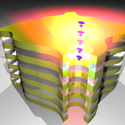Drilling for tunable photons in a nanohole
When free electrons interact with a periodic structured environment, such as the surface of a metal grating, they emit photons . The same principle guides the operation of the free-electron laser, whereby a beam of relativistic electrons passes through a spatially periodic transverse magnetic field, generating tunable, coherent, high-power radiation .
Writing in Physical Review Letters, Giorgio Adamo and colleagues from the University of Southampton in the UK, and collaborators in Taiwan and Spain, take the concept of tunable light sources into the realm of the nanoscale. Adamo et al. fire an electron beam through a 700- nm-diameter hole in a stack of alternating silica and gold layers, each 200nm thick. As the electrons travel through the periodically layered structure, they emit near-infrared photons whose frequency can be tuned by adjusting the electron energies in the 20– 40 keV range. The tunability of this “light well,” together with its compact size, makes this device potentially interesting as an on-chip light source for nanophotonic circuits, or in optical memory and display applications. Scaling the concept from the THz range to the UV appears within reach by varying the periodicity of the structure.
At this proof-of-concept stage there are caveats: The emitted light is incoherent and the photon conversion process is hampered by losses, with only 2– 4 photons emitted per 100 000 electrons at maximum intensity. If the technical challenges presented in this demonstration can be surpassed, Adamo et al.’s results could pave the way for a new generation of on-chip tunable light sources. – Manolis Antonoyiannakis
[1] S. J. Smith and E. M. Purcell, Phys. Rev. 92, 1069 (1953).
[2] L. R. Elias et al., Phys. Rev. Lett. 36, 717 (1976); D. A. G. Deacon et al., Phys. Rev. Lett. 38, 892 (1977).





